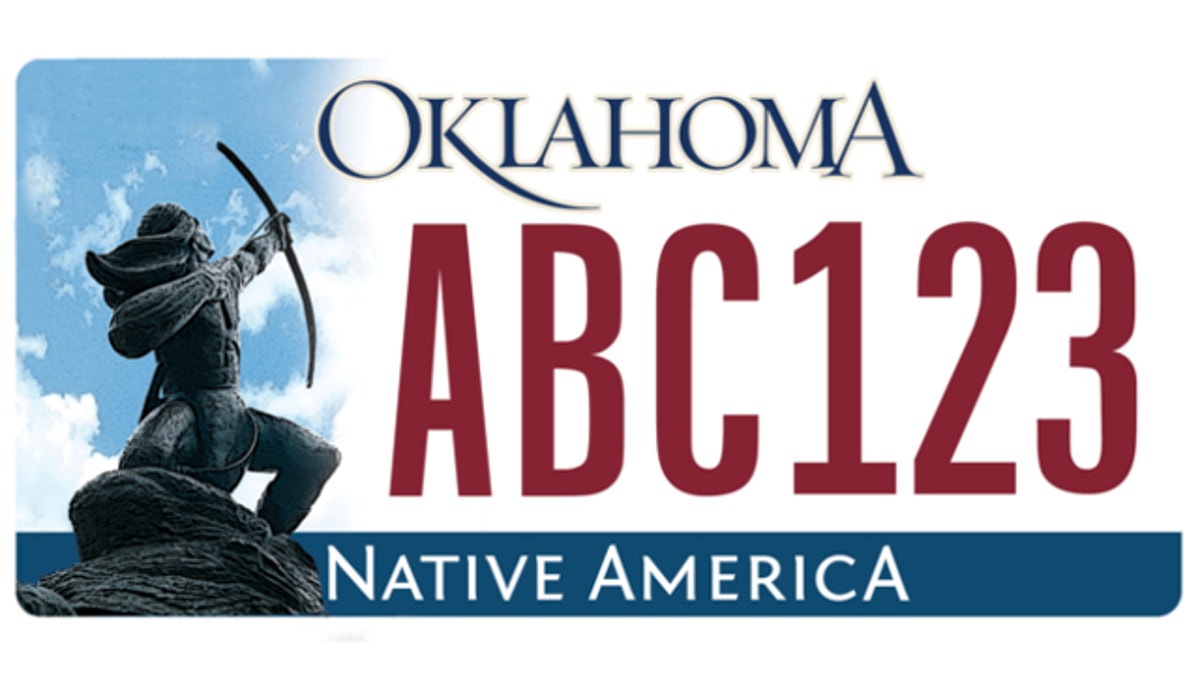
FILE: An image of a young Apache warrior is shown on a sample Oklahoma license plate. (OK.Tax.Gov)
OKLAHOMA CITY – When Oklahoma looked to redesign its license plate five years ago, the iconic image of a young Apache warrior shooting an arrow skyward depicted in Allen Houser's "Sacred Rain Arrow" statue was a clear choice of a public that looked at more than 40 designs that featured Native American art, cowboy images and western and wildlife themes.
Tourism officials hailed the license plate as a traveling billboard for Oklahoma, and the image was deemed the best license plate in the nation in 2009 by the American License Plate Collectors Association.
But a Methodist minister claims the plate is an affront to his Christian beliefs, and a federal appeals court ruled last week that the minister's case can proceed.
"I think it's important to understand that whether it was a Native American symbol or a symbol of any other faith, the issue would be the same," said Keith Cressman, pastor at the St. Marks United Methodist Church in Bethany.
Cressman referred additional questions to his attorney, Nathan Kellum of the Memphis, Tenn.-based Center for Religious Expression.
Kellum said his client isn't asking the state to get rid of the roughly 2.9 million license plates on the road that feature the image, only that his client be given another option to place on his vehicle.
"He simply wants to avoid placing the tag with the objectionable image on his car," Kellum said. "Whether that is through an alternative plate without an additional cost, or just some method in which he would not have to be a mobile billboard for the state's message against his will."
Oklahoma Department of Corrections inmates manufacture license plates at a cost to the state of about $2 each, according to the Tax Commission.
Oklahoma has more than 200 specialty license plates featuring things like logos for schools and universities, wildlife, and even one featuring the phrase "In God We Trust," although each specialty plate requires an additional fee ranging from about $18 to $35 annually.
The "Sacred Rain Arrow" image that ultimately was chosen for Oklahoma's license plate five years ago is a likeness of the statue by noted American Indian sculptor Allan Houser, a Chiricahua Apache artist recognized as one of the foremost sculptors of the 20th Century. The statue, which was displayed at the Olympic Village during the 2002 Olympic Winter Games in Salt Lake City, features a warrior shooting the arrow skyward as part of a ritual involving a prayer for rain. The statue is now displayed outside the Gilcrease Museum in Tulsa.
"The piece isn't worshipping a rain god," said David Rettig, curator of collections for the Allan Houser estate in Santa Fe, N.M., who knew Houser for 20 years before the artist's death in 1994. "It is, in a sense, an offering of prayer to the God. The idea this piece is worshipping some pagan god is pretty foreign to what he believed.
"(The minister) is missing the point that it symbolizes Native American culture and history and I don't think it's making some kind of exclusive statement about religion or worship. It's puzzling somebody could take that interpretation."
State Sen. Clark Jolley sponsored the bill to create a new license plate five years ago to replace Oklahoma's old tag that featured an Osage Nation shield that is also depicted on the state flag. Jolley also helped lead a panel to narrow the selection down to five finalists and said there wasn't any thought given to the religious significance of the design.
"I don't think any of us had any thought that this was some kind of great statement of religious significance," said Jolley, R-Edmond. "I'm not an expert on Native American religious heritage. I just thought of a guy shooting an arrow into a cloud so that rain would fall."
Charles Vargas, a member of the Chiricahua Apache Nation's governing board, said the tribe's ancestral lands ranged from what is now Arizona and New Mexico into the high plains of Oklahoma and that many tribe members are honored that the license plate features a Chiricahua Apache warrior.
"I think it's very powerful imaging, and it's used in a very positive manner," Vargas said. "If it's something the people want in that state, how could we deny that."
Billy James, a 29-year-old student at the University of Oklahoma, said he has always liked the design of the license plate.
"I definitely like keeping the Native American history on the license plate," said James, who is Catholic. "I think it's a good reminder of where we came from. I think it's a good representation of our state.
"I find the history of other people's beliefs in no way offensive to my own beliefs."
Cressman's attorney said his client's lawsuit is in no way a criticism of Native Americans or their rich history in Oklahoma.
"It's really the idea that he would have to communicate a religious belief that he doesn't hold," Kellum said.
When asked about the case, Oklahoma Attorney General Scott Pruitt, whose office represents the state, said only that attorneys on his staff were evaluating the decision.
"We're doing what we do in every case," Pruitt said. "We're evaluating and analyzing the case as the 10th Circuit sent it back."
The three-member panel of the Denver-based U.S. Court of Appeals for the 10th Circuit did not rule on the merits of the case, but in a 2-1 decision reversed the district court's order dismissing Cressman's complaint and sent the case back for further consideration.

